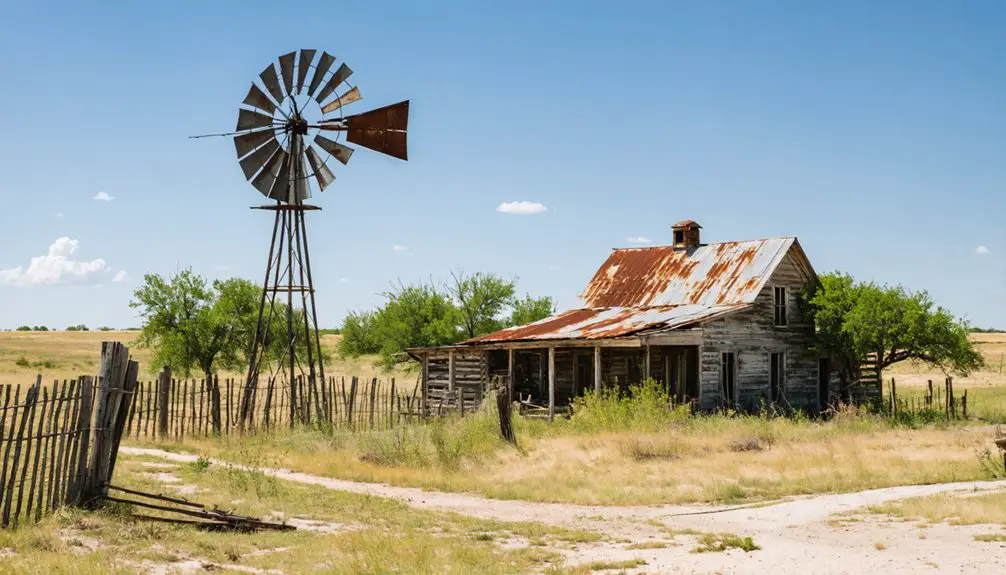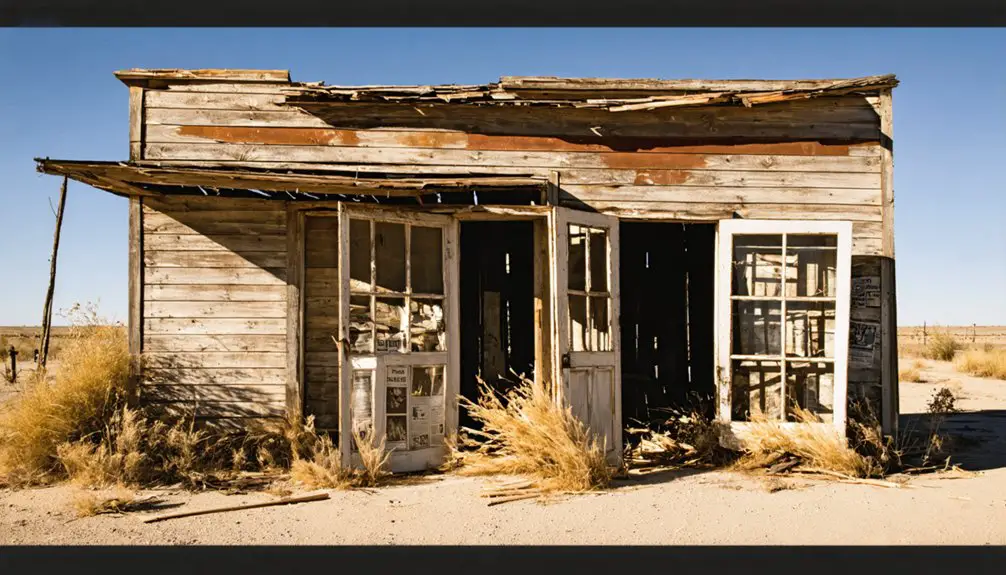You’ll find Ayres, Texas in Washington County, where Stephen F. Austin’s colonists established an agricultural settlement in 1835. Named after the Scottish port of Ayr in 1890, this once-promising community declined after losing both the county seat battle and hoped-for Fort Worth railroad connection. By 1895, its store and post office had closed. The empty buildings and lost dreams of Ayres mirror countless stories of Texas frontier settlements waiting to be discovered.
Key Takeaways
- Ayr, Texas was established in 1835 as an agricultural settlement and named in 1890 after the Scottish port city Ayr.
- The town’s decline began after losing a county seat battle in 1890 and being bypassed by the Fort Worth railroad line.
- By 1895, Ayr’s economic isolation led to the closure of its store and post office, leaving abandoned buildings.
- The community’s Scottish Highland heritage influenced early development through farming practices and social structures.
- Transportation challenges and political struggles with La Plata contributed to Ayr becoming a ghost town.
Origins and Early Settlement
When Stephen F. Austin authorized the establishment of Ayres around 1835, he envisioned a thriving agricultural settlement in Washington County’s fertile lands.
You’ll find that David Ayres, one of the founding families, played a significant role in the community’s initial development, leading to the town bearing his name.
The settlement emerged during Texas’s early colonization period, with Anglo-American settlers transforming the eastern Texas landscape through their agricultural practices.
You’ll notice they strategically positioned their homesteads near essential water sources and travel routes, clustering buildings for mutual protection.
The surrounding environment, with its mix of prairie and forest, provided ideal conditions for farming and ranching.
The community’s social structure centered on land ownership, with families focusing on subsistence farming while gradually building essential community services.
Like the historical L. S. Ayres department store that would later emerge in Indiana, the town aimed to become a center of commerce for the region.
The town established a post office and store in its early years, serving as vital amenities for the growing community.
The Scottish Connection
You’ll find strong Scottish heritage in the naming of Ayr, Texas, which was explicitly chosen after the Scottish port city of Ayr when the townsite was platted in Deaf Smith County in 1890.
Like many Texas settlements influenced by Scottish immigrants and their descendants, Ayr’s name reflected both cultural pride and economic aspirations, paralleling its namesake’s role in trade and commerce.
The choice of a Scottish place-name aimed to attract settlers and investors by connecting the new frontier town to established old-world traditions of stability and prosperity.
Initial development brought a store and post office to serve the early settlers.
The Fort Worth and Denver railway surveyors established the town in January 1890, positioning it five miles from the county center.
Scottish Naming Heritage
The surname Ayres traces its roots to the ancient Scottish/English Borderlands, specifically among the Strathclyde-Britons, a Celtic people who inhabited southwestern Scotland.
You’ll find the name’s strongest connections in Ayrshire (Siorrachd Inbhir Àir), where the Ayres family maintained their ancestral seat.
Like many Scottish surnames of Celtic heritage, Ayres evolved through various spellings including Ayre, Ayer, and Air. The surname’s diversity emerged from phonetic spelling by scribes as translation practices were still developing.
Early records reveal prominent Scots bearing this name, such as Reginald Ayr, who served as Clerk of Ayr in 1287, and Albinus Ayr, who received land grants from Robert the Bruce in 1315.
The name’s linguistic heritage blends Gaelic, Norse, and Old English influences, reflecting Scotland’s rich cultural tapestry and the complex origins of highland and lowland naming traditions. Some bearers of the name originated from Middle English eir, meaning heir to large estates.
Highland Settlers Influence
Scottish Highland heritage shaped the early development of Ayres, Texas through its founding settlers‘ deep-rooted cultural practices and traditions.
The Ayres family and fellow Highland-descended settlers brought their ancestral customs of farming, military leadership, and community cohesion to the Texas frontier. Following their forefather’s example as a licensed tavern operator, early settlers established vital gathering places that served as community strongholds. During difficult times like the Great Depression, many families had to relocate and seek new opportunities.
You’ll find evidence of Highland customs in how these settlers organized their community, from their agricultural practices to their social structure. They established grain mills, managed livestock, and maintained strong kinship networks reminiscent of clan systems.
Their military experience, carried over from Scottish traditions, proved valuable in frontier defense and community leadership. They created lasting institutions built on Highland values of education, faith, and mutual support, while adapting their inheritance customs and land management practices to suit their new Texas home.
Railroad Dreams and Development
You’ll find that Ayres’s early railroad ambitions centered on establishing a station along the proposed Fort Worth line, which would have connected the settlement to larger regional markets.
Local residents enthusiastically anticipated the economic boost a rail connection might bring, particularly for agricultural shipping and passenger service. Similar to the Texas Trunk Railroad that struggled between Dallas and Kaufman, transportation initiatives in the region often faced financial difficulties.
While survey markers were placed and preliminary plans drawn, the Fort Worth line ultimately bypassed Ayres, dealing a significant blow to the town’s development prospects.
Poor road conditions made transportation exceptionally difficult, with ox carts only managing to cover minimal distances each day.
Railroad Station Plans
During early railroad development in Texas, plans for a new station emerged when the Texas & New Orleans Railroad conducted a survey in 1900 near the communities of Kickapoo and Fincastle.
The railroad company identified a scenic location that would serve as a crucial community hub, leading to the establishment of a new town.
You’ll find the station’s architecture reflected the typical design of early 1900s Texas railroad depots, featuring both passenger and freight services.
Originally named Ayres after a local physician, the station and post office were strategically placed south of the town square.
In 1902, they were renamed Frankston, honoring Miss Frankie Miller’s land donation for a city park.
The station’s multipurpose design and location maximized commercial activity, making it central to the area’s development.
Fort Worth Line Connection
The railroad’s “No settlers, no trains” policy drove regional development, while strategic partnerships with other railroads enhanced Fort Worth’s position.
By 1904, the city’s downtown featured an essential junction where the Texas & Pacific’s east-west line intersected with north-south routes operated by Katy, Santa Fe, and Houston & Texas Central railroads.
These companies jointly constructed Tower 55, Texas’s largest interlocking plant, featuring an advanced 122-function signal system.
Local Politics and Power Struggles
While frontier towns often competed for political dominance, few rivalries matched the intensity of Ayr and La Plata’s 1890 battle for county seat status in Deaf Smith County, Texas.
The powerful XIT Ranch’s political maneuvering heavily influenced the outcome, using its considerable ranching interests to establish and control La Plata.
The XIT Ranch flexed its substantial ranching power to manipulate local politics, establishing La Plata as its controlled outpost.
When election day arrived, La Plata won by a suspicious 97-7 margin, prompting allegations of fraud and requiring Texas Rangers to maintain order.
- The county seat designation determined a town’s fate, controlling everything from rail access to government services.
- Large ranching corporations like XIT wielded immense power over territorial development and local governance.
- The loss of county seat status led directly to Ayr’s abandonment, showing how political decisions shaped the frontier’s destiny.
Life in Early Ayr

Life in frontier Ayres centered around David Ayres’s pioneering vision when he established the settlement in 1835.
You’d find families working their homesteads, raising livestock, and tending to early agriculture that sustained the community’s basic needs. As a devout Methodist leader, Ayres fostered regular community gatherings that brought settlers together for worship and social connection.
You’d witness the town’s close-knit nature during times of crisis, like when residents banded together during the Runaway Scrape, or when families took care of each other’s children – as Ayres did for William B. Travis’s son during the Alamo siege.
Daily activities revolved around mercantile trade, farming, and religious services, creating a rhythm of life typical to Texas frontier settlements of that era.
The Battle for County Seat
During 1890, tensions erupted between two ambitious settlements in Deaf Smith County as they vied for political dominance.
You’d have found Ayr and Grenada (later La Plata) locked in a fierce battle for the county seat, with Texas Rangers stationed nearby to prevent violence.
The October election ended in La Plata’s landslide victory of 97 to 7, though claims of election fraud surfaced afterward.
The XIT Ranch’s powerful backing of La Plata proved decisive, representing corporate ranching interests‘ triumph over independent settlers.
- The county seat battle shaped the Texas Panhandle’s political landscape, showing how corporate influence could determine a town’s fate
- Your freedoms in frontier democracy faced challenges from wealthy ranching interests
- The contest’s intensity revealed how vital county seat status was for a settlement’s survival
Economic Challenges and Decline

After losing the county seat battle in 1890, Ayr’s economic foundations crumbled rapidly.
You’d have witnessed the town’s dramatic decline as the Fort Worth and Denver City Railway abandoned plans for a vital spur line, leading to severe economic isolation. Without rail access, ranchers couldn’t efficiently ship cattle from Roswell, and merchants lost their competitive edge to neighboring towns.
The railway’s departure sealed Ayr’s fate, leaving ranchers stranded and merchants struggling against better-connected rival towns.
The settlement disillusionment hit hard as investors and settlers fled to better-positioned communities like La Plata, where the influential XIT Ranch held sway.
You couldn’t sustain a business in Ayr when nearby towns offered railway connections and county administration benefits. By 1895, Ayr’s store and post office had shuttered, leaving behind empty buildings as evidence of unfulfilled promises of prosperity through transportation and ranching commerce.
Legacy and Historical Impact
The historical footprint of Ayres extends far beyond its brief existence as a settlement. As part of Stephen F. Austin’s colonization efforts in 1835, this Washington County town represents essential demographic changes that shaped Texas’ early development.
You’ll find its cultural significance deeply woven into the fabric of pioneer life, reflecting the spirit of freedom that early settlers sought in the Texas frontier.
- The town’s establishment and decline mirror the broader pattern of rural settlement evolution in 19th-century Texas.
- Its connection to David Ayres and Stephen F. Austin places it within the core narrative of Texas’ foundational history.
- The site serves as a reflection of how transportation routes and political dynamics influenced the survival of early Texas communities.
Modern Day Remnants

Today’s visitors to Ayres will find little more than scattered ruins and overgrown pastureland where this once-promising settlement stood in Deaf Smith County. The few abandoned structures that remain are mostly reduced to foundations, with the former post office and store locations marked only by their historical significance rather than standing buildings.
You’ll find the land has largely returned to its agricultural landscape, now privately owned and used primarily for cattle grazing and farming. Unlike some preserved Texas ghost towns, Ayres lacks interpretive markers or guided tours.
The semi-arid plains environment has gradually reclaimed the site, with weathering taking its toll on any surviving remnants. If you’re exploring, you won’t find much beyond occasional building debris and scattered artifacts, as the area’s shift from town to ranchland is nearly complete.
Frequently Asked Questions
Were There Any Notable Crimes or Outlaws Associated With Ayr?
You won’t find any documented outlaw history or crime legends in Ayr’s brief existence. Despite Texas Rangers’ presence during the 1890 county seat dispute, no major criminal activity was recorded.
What Types of Wildlife Were Commonly Found Around Ayr During Its Existence?
Though records are limited, you’d have encountered rich wildlife diversity in Ayr’s prairie-woodland ecosystem, from white-tailed deer and coyotes to cardinals and bobcats in their natural Texas habitats.
How Did Seasonal Weather Patterns Affect Daily Life in Ayr?
You’d face brutal winters with blizzards and scorching summers with drought, making seasonal agriculture nearly impossible. These climate challenges disrupted your daily routines, from gathering supplies to maintaining shelter.
Did Any Famous Personalities or Historical Figures Ever Visit Ayr?
You won’t find any documented celebrity sightings in Ayr’s history. Unlike other Texas ghost towns with famous visitors, Ayr’s historical significance stems purely from its railroad origins and county seat rivalry.
What Was the Average Property Value of Land in Ayr?
Like a puzzle missing its pieces, you won’t find exact property values for Ayr’s brief market. No records survived showing what land ownership cost during the town’s fleeting 1890s property market.
References
- https://mix941kmxj.com/see-how-two-texas-ghost-towns-battled-for-the-county-and-lost/
- https://www.youtube.com/watch?v=Zd8-gKw-5Hc
- https://www.texasescapes.com/TexasPanhandleTowns/Ayr-Texas.htm
- https://www.youtube.com/watch?v=mQJonzJBYK8
- https://authentictexas.com/texas-ghost-towns/
- https://en.wikipedia.org/wiki/List_of_ghost_towns_in_Texas
- https://sites.rootsweb.com/~txdeafsm/history/ghost-towns.htm
- https://www.tshaonline.org/handbook/entries/ayres-tx
- https://en.wikipedia.org/wiki/Ayres
- https://www.youtube.com/watch?v=phjUE19A8HM



